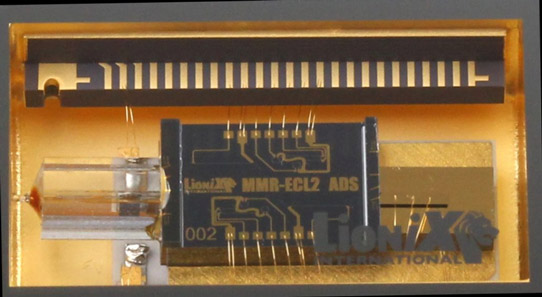- News
7 July 2017
University of Twente develops record 290Hz-linewidth narrowband laser
Working in collaboration with LioniX International BV of Enschede, The Netherlands, researchers at the University of Twente’s MESA+ research institute have developed what is claimed to be the most narrowband diode laser on a chip, targeting applications such as 5G Internet and accurate GPS closer (Youwen Fan et al, ‘290 Hz Intrinsic Linewidth from an Integrated Optical Chip-based Widely Tunable InP-Si3N4 Hybrid Laser’, Conference on Lasers and Electro-Optics (CLEO): Applications and Technology 2017, paper JTh5C.9).
The University of Twente researchers have developed a laser on a chip with a maximum bandwidth (the maximum uncertainty of frequency) of just 290Hz, which is claimed to be by far the most accurate laser on a chip ever created. “Our signal is more than ten times more coherent – or clean – than any other laser on a chip,” says lead researcher professor Klaus Boller.
The new InP-Si3N4 hybrid laser (comprising two photonic chips, optically connected to each other) is also tunable over a broad spectral range (81nm at 1550nm).


The integrated-photonics narrowband tunable laser was fabricated on a chip provided by LioniX (top). A laser-gain section is hybridly attached to a tunable reflector photonic integrated circuit (PIC), creating an external-cavity laser (bottom). The gain section creates the first mirror and the necessary gain, while the silicon nitride (Si3N4)-based portion (created using LioniX’s TriPleX process) acts as a tunable wavelength-dependent mirror.
It is reckoned that the record-setting laser could bring many applications within reach, such as controlling movable antennae on phone masts for 5G mobile Internet, faster data flows through fiber-optic networks, or more accurate GPS systems and sensors for monitoring the structural integrity of buildings and bridges.
The research was carried out by Youwen Fan and Klaus Boller of the Laser Physics and Nonlinear Optics department at the University of Twente MESA+ research institute, Applied Nanophotonics, in collaboration with Ruud Oldenbeuving, Chris Roeloffzen, Marcel Hoekman, Dimitri Geskus, and René Heideman at LioniX.
www.osapublishing.org/abstract.cfm?URI=CLEO_AT-2017-JTh5C.9


